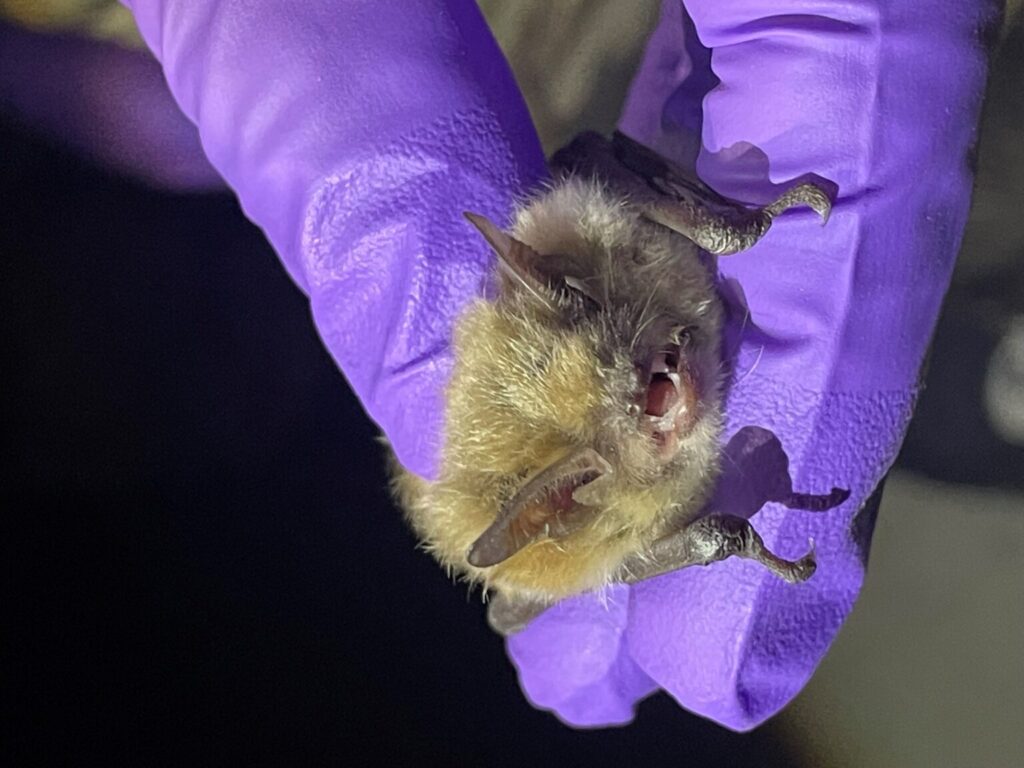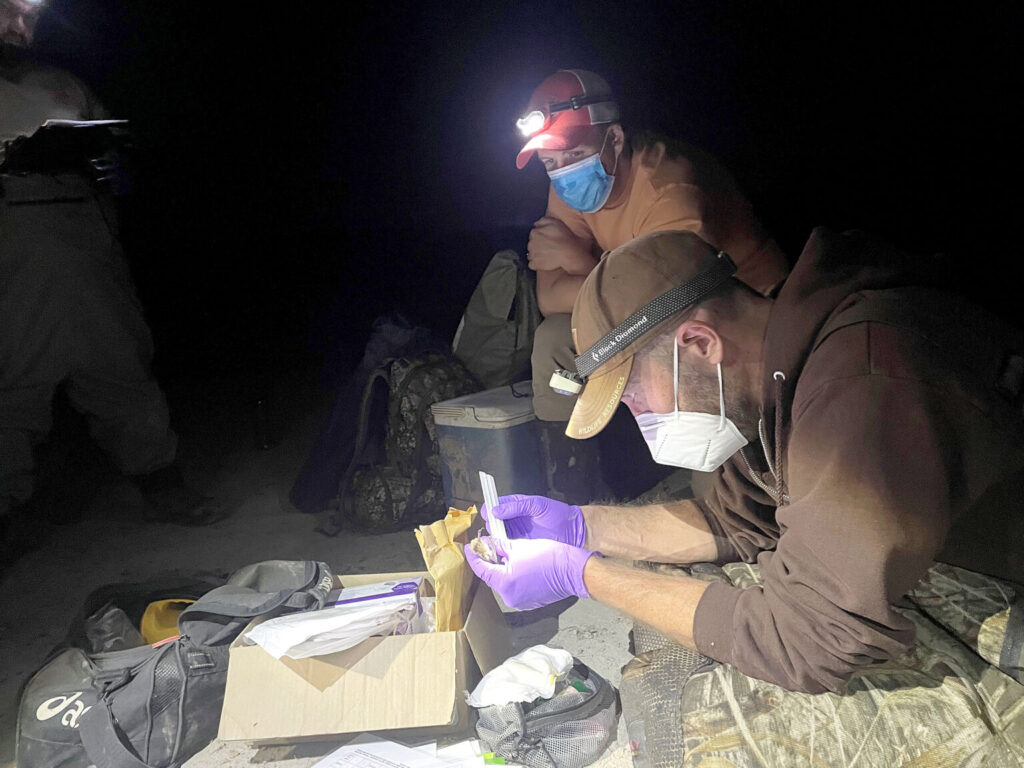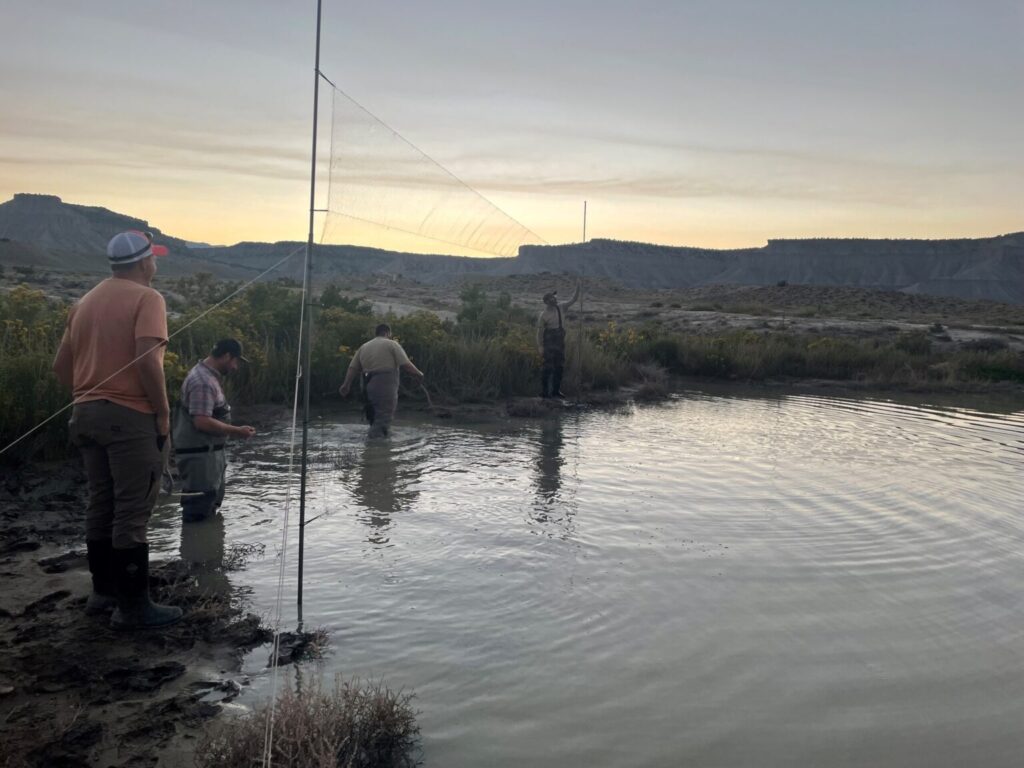Wildlife students find unexpected visitors


DWR Scott Gibson measures the bat. 
Students wander around water looking for bats.
The phrase “blind as a bat” is a misnomer, even though the small eyes resemble that of Mr. Magoo, bats actually have sensitive colorless vision that helps them see in dark nights.
This is one of several bat facts USU Eastern students’ learned on a bat outing with Wildlife Conservation Biologist Scott Gibson of the Utah Division of Wildlife Resources (DWR) on a cool September evening. Students in Dr. Sunshine Brosi’s Wildlife Techniques and Mammalogy courses set out on an evening adventure to catch and collect scientific data on bats a few miles from campus in Carbon County.
Before dusk the students geared up in fishing waders and set up fine “mist” nets around a small pond to catch bats which drink and feed on insects, such as moths, attracted to the water. The bats often detect the nets but we still hoped to catch a bat, so we waited.
The stars came out while the moon shined on the majestic Pinnacle Peak in the distance. The students commented on how lucky we are to get to hang out in the beautiful desert as part of our classwork here at USU, Eastern.
This class, like many others in the Wildlife Ecology and Management major, involves students going outside, walking through the mud, and experiencing first-hand the jobs of wildlife managers.
“This is the second field trip I’ve taken in Dr. Brosi’s class, I really enjoy getting to go outside and learn real field skills”, said a USU Eastern wildlife student. Every fifteen minutes or so we went out to the nets with headlamps to look for captured bats.
After a few hours of waiting, snacks, and conversations about how to get jobs with DWR—it happened! We saw a small, nocturnal mammal, struggling in the net, a Yuma Myotis bat, aka Myotis yumanensis! Students quickly put on our masks so we could get a closer look and Scott Gibson expertly and quickly untangled the bat from the source of capture.
Out came the data sheets and we recorded information on the bat such as weight, about the same as three dimes, and specific anatomical features unique to this species. Students got to see how and the importance of wearing gloves and masks when handling bats to prevent the spread of many diseases, including SARS Covid-19.
“It is important for students to see the connections of other species in their every day lives. We learn about emerging wildlife diseases spread to humans due to human encroachment into their habitats, and we learn techniques for managing wildlife and meet our future employers,” said Dr. Brosi.
This beautiful pale brown bat feeds over water, eating a variety of aquatic insects, moths, and importantly mosquitoes and flies. Reducing mosquito populations is just one the vital ecosystem services that bats provide. Bats also reduce agricultural pests; some studies estimate they eat up to $53 billion in crop plants and even more when we consider forests pests. Some other bat species even pollinate important crops and plants vital to other species in ecosystems.
Because of the recent rains the small pond that we sampled contained water—but this isn’t always the case. Yuma Myotis and other bats are threatened by the unprecedented drought and climate change in the arid southwest. Bats are one of the many species that benefit by waterwise actions including planting native drought-tolerant plants. Learn more about water-saving activities you can do by visiting: utahwatersavers.com.
Another potential future threat to bats in Utah is a disease called white-nose syndrome caused by the fungus, Pseudogymnoascus destructans, or Pd for short, named after the production of white mycelia (or fruiting bodies) on the noses of bats. This fungus causes bats to use up vital stores of fat during winter hibernating periods and results in bats flying around in daylight in winter searching for insects—which are nowhere to be found because of the cold weather. White-nose syndrome, first detected in 2006 in the United States, has been found this year in California, New Mexico, and Wyoming—but it has yet to be detected in Utah.
More information about this disease can be found on this website: www.whitenosesyndrome.org. Be on the lookout this winter for bats flying during the day or dead and dying bats and contact the Price Field Office of DWR if you find dead or dying bats. Make sure to never touch bats, even ones that you expect are dead, with your bare hands!
The Yuma Myotis bat species roost in abandoned cliff swallow nests, bridges, but can also be found in buildings. DWR has critical information about what to do if you find a bat in your house, wildlife.utah.gov/news/utah-wildlife-news/973-what-to-do-if-you-find-a-bat-in-your-house.html.
One way that we can successfully coexist with bats is to put up artificial tree bat roosts in our own yards to encourage them away from our houses, rocket boxes and rocket roosts available online are a great option for homeowners.
If you too would like to go batty with Dr. Sunshine Brosi send her an email at [email protected] or stop by Reeves 260 to find out more information about the Wildlife Ecology and Management major at USU Eastern.




